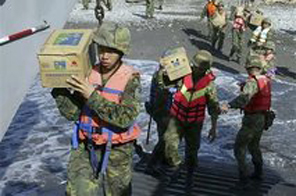Taiwan awaits aid for storm relief
SHIAO LIN: Taiwan awaited desperately needed aid from the United States, China and other countries Sunday as villagers mourned the hundreds who were killed in the worst storm to strike the island in 50 years.
Taiwan's Foreign Ministry said giant helicopters from the U.S. that can carry cranes and backhoes were expected to arrive in a few days to help rescue those that might still be trapped, and to help rebuild roads in villages devastated when Typhoon Morakot hit a week ago. The U.S. has also agreed to send other relief materials, it said in a statement, without elaborating.
Resettlement of the estimated 7,000 people whose homes were destroyed by mudslides and flooding could speed up after the first batch of prefabricated homes promised by rival China arrive Monday, the island's disaster relief center said.
Displaced people have been staying at temporary shelters or with relatives.
More than 59 countries have offered aid to Taiwan, including Israel, Australia and Singapore, the Foreign Ministry said. Pope Benedict XVI also donated $50,000.
Taiwanese President Ma Ying-jeou put the overall death toll on Friday at about 500, making it the island's deadliest weather disaster since 1959 when more than 600 perished in a typhoon.
Morakot dumped more than 80 inches (2 meters) of rain on Taiwan and stranded thousands in villages in the mountainous south. As of Saturday night, a total of 21,199 villagers had been ferried to safety and rescuers were working to save another 4,224 people.
The rescue operation has relied mainly on helicopters because bridges collapsed and roads were washed away. At the Cishan landing zone in the south — a main drop off point for those rescued — hundreds have waited anxiously for days hoping to find any relatives airlifted to safety.
In Shiao Lin, the worst-hit village where 380 out of a population of 600 were buried under tons of rubble, the red-clad rescue workers searched the ground for human remains.
Shiao Lin was obliterated last weekend when rains spawned by Morakot loosened the foundations of two nearby mountains and sent their facades tumbling down onto its 200 or so homes.
Friends and relatives of the victims gathered at the site of the village on Saturday, burning incense, carrying photos of their loved ones and weeping inconsolably under a gray and ominous sky.
Walking unsteadily near the remains of the Tai Tz Temple — one of only two buildings still standing — Liu Jin-fung shook his head repeatedly. He said the storm had changed his life beyond all recognition.
"My parents, my brothers, my uncles, altogether 40 of my family members were killed," he said. "How can I plan for the future? Everything is gone from my world."
Standing close to a relative in Shiao Lin, 12-year-old Chiu Yao-wen gazed at a color photograph of Pan Hsia-yen, her 8-year-old niece, and buried her head in her hands.
"She's gone," Chiu said. "Her and her whole family. They're all gone now."
In the valley below, relatives and friends of the dead made their way unsteadily through the mud and rubble that consumed the village.
Clutching each other for support, they moved back and forth across the thousands of rocks and hundreds of shattered tree trunks that swept down from the mountains when they collapsed six days earlier.
Shiao Lin is located in a narrow valley formed by the Nan Tz Hsien River, which burst its banks when torrential rains began falling before last weekend.
Underfoot the soil is still sponge-like and mushy, and the sound from the dozens of rain-fed streams flowing over the ground — gently now, finally gently — is strangely soft.
Shiao Lin's two remaining structures stand broken and fractured amid a pair of tall palm trees — a dun colored house that survived the disaster because it was located on relatively high ground, and the adjacent Tai Dz Taoist temple, its walls falling apart.
On either side of the valley, the mountains that buried the village were visible through a thin mist, the northern peak's once verdant face stripped clean away, and 800 feet (260 meters) of its original mass lying below on the ground.
Liu Suan-dz, the owner of the house, said he was in Taipei when the disaster struck and was now returning to the village for the first time.
"It's finished here, all of it," Lui said, inspecting the mud-encased floors, the shards of wood that were once his furniture, and the storm's high watermark, clearly visible near the ceiling. "There's nothing left to come back to."






